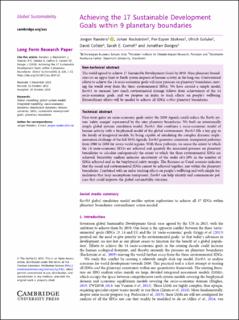| dc.contributor.author | Randers, Jørgen | |
| dc.contributor.author | Rockström, Johan | |
| dc.contributor.author | Stoknes, Per Espen | |
| dc.contributor.author | Golüke, Ulrich | |
| dc.contributor.author | Collste, David | |
| dc.contributor.author | Cornell, Sarah E. | |
| dc.contributor.author | Donges, Jonathan F. | |
| dc.date.accessioned | 2021-01-21T09:46:01Z | |
| dc.date.available | 2021-01-21T09:46:01Z | |
| dc.date.created | 2019-12-10T09:31:52Z | |
| dc.date.issued | 2019 | |
| dc.identifier.issn | 2059-4798 | |
| dc.identifier.uri | https://hdl.handle.net/11250/2724062 | |
| dc.description.abstract | The world agreed to achieve 17 Sustainable Development Goals by 2030. Nine planetary boundaries set an upper limit to Earth system impacts of human activity in the long run. Conventional efforts to achieve the 14 socio-economic goals will raise pressure on planetary boundaries, moving the world away from the three environmental SDGs. We have created a simple model, Earth3, to measure how much environmental damage follows from achievement of the 14 socio-economic goals, and we propose an index to track effects on people's wellbeing. Extraordinary efforts will be needed to achieve all SDGs within planetary boundaries. | |
| dc.description.abstract | Achieving the 17 Sustainable Development Goals within 9 planetary boundaries | |
| dc.language.iso | eng | |
| dc.title | Achieving the 17 Sustainable Development Goals within 9 planetary boundaries | |
| dc.type | Peer reviewed | |
| dc.type | Journal article | |
| dc.description.version | publishedVersion | |
| dc.source.volume | 2 | |
| dc.source.journal | Global Sustainability | |
| dc.identifier.doi | 10.1017/sus.2019.22 | |
| dc.identifier.cristin | 1758614 | |
| cristin.unitcode | 158,12,0,0 | |
| cristin.unitname | Institutt for rettsvitenskap og styring | |
| cristin.ispublished | true | |
| cristin.fulltext | original | |
| cristin.qualitycode | 1 | |
